Text life after death
Posted by Richard on UTC 2019-07-16 14:03
Scholars have expended much energy and ingenuity on analysing the sequence of Catullus' poems that we find in the codex. It is possible to argue for a degree of randomness in the collection as we have it; it is also possible to bring subsets of poems together into smaller collections; it is possible to argue that these smaller collections led independent existences until they were brought together posthumously in the whole we have today. In our profound ignorance, we can argue anything we want to.
If Catullus died young, as we suspect, death may well have surprised him. The luxury of knowing that death is waiting for you a few months or a year hence is a liberation only some modern terminally ill people enjoy – time to put your affairs in order, drink immoderately, borrow lots of money, work down the bucket list and so on.
If only for this reason, that Catullus was ambushed by death, we simply cannot assume that the order of poems in the collection we have today was any doing of the poet himself, in fact, in the circumstances, we should assume the opposite: it seems unreasonable to expect that Catullus gathered his work into an orderly monolithic collection either during his short lifetime or at its end.
Furthermore, if the order we have today is indeed that originally made by Catullus himself we can only say that poets occasionally do the strangest things: surely, for example, no lyrical poet would document in numerous poems his blazing passion for his Lesbia and then scatter them in a completely erratic sequence throughout his 'book'; no poet would group his work without regard to chronology or subject but according to the metrical schemes used.
It is inconceivable that [c 1], the 'dedication' poem cheekily placed at the beginning of the collection as we have it today, applies to such a huge bundle of work. If anything, its existence reinforces the view that there must have been at least one smaller collection on a single roll made by Catullus himself during his lifetime.
There are many reasons for not taking the 'book' of Catullus' poems as being a single, integral work. Scholars now believe that in the years after Catullus' death a number of papyrus rolls were in circulation, perhaps five or six or more, containing various collected subsets of Catullus' poetry, possibly organized around metrical styles or themes. The existence of the dedication, [c 1], suggests that at least one of the rolls was put together by Catullus himself, but leaves unanswered the question of whether this roll (or one or more copies) survived his death and was among the set of rolls that was in existence four centuries later. There is no reason to assume that the contents of these minor collections were immutable, as new copies were made.
We can easily imagine that those having copies made for their own use might restrict the selection to their own personal favourites – they are after all poetry lovers, not poetry editors. He who pays the copyist piper calls the tune, particular when each poem copied will cost some money. There may well have been hundreds or even thousands of personal copies of rolls containing various permutations of his poems scattered throughout the Empire.
In sum, we have no real idea what happened to Catullus' poetry during his life and for centuries after his death. No rolls from this time have survived and so we have no evidence that will help us bring some order into this textual anarchy. We have speculations and lots of questions – and lots of answers, all of which are the same: don't know. Catullus' poetry never made the entry into the pantheon of received Latin texts, the canonical texts that were copied, maintained and circulated for teaching purposes. They had to survive on their own merits. How they did that we do not know.
The dying of the roll
Whatever permutations of Catullus' poems we have floating around Rome or Verona or Sirmio or the outer reaches of the Empire, at some point these papyri, whether sheets or rolls, made the jump over the great technological hurdle that arose around the fourth century BC, the invention of the forerunner of the book, the codex.
As a technological concept the codex was the future: we don't use scrolls these days, except in Judaism and – ironically enough – in web page interfaces. In contrast, you can still buy the descendant of the codex in any bookshop.
The codex allowed random access to its pages, protected its pages better because they were not subject to constant rolling and unrolling and could accommodate more pages in a single codex than in a scroll. Scrolls went out of fashion, then out of use, then time culled them.
But only the most important texts on rolls were seen to be worth the trouble of copying onto codex pages. Moderns have faced waves of similar transitions with a number of technological obsolecences such as wax cylinders, shellac records, vinyl records, cassette tapes, VHS video, chemical-based photography. At each technological border-crossing the problem is the same: what do you leave behind and what do you pay to take with you? What to do with forty decades of photographs on negatives and prints?
The progress of audio recordings during the 20th century from wax rolls to digital storage illustrates exactly this process. Few wax cylinders were copied to shellac records, few shellac records were copied to vinyl – and so on along the technological hurdle race: music cassettes, CDs, then finally digital storage. At each hurdle, most of the runners fell, floored by the cost and difficulties of making the transition – only the most valuable survived. A friend of my youth had a large collection of recordings by Jelly Roll Morton et al. At that time he could do nothing with them other than wear them down by playing them.
Only now that digital recording and storage is free and available to almost anyone is the material from wax cylinders, shellac and vinyl recordings jumping this last, very low hurdle. It seems as though all the records in my friend's jazz collection can now be played and downloaded in digital formats with ease.
Perhaps you are not far-sighted enough to plan ahead, meaning that all those cassette tapes and photographs are consigned to oblivion only a short while after their owner's now worthless corpse. That is exactly how it was with the transition between papyrus rolls and parchment codices.
Once the transition was complete the scroll was disposed of. Our obsessive reverence for the innate value of old things was not shared by our ancestors, who pitilessly destroyed what was surplus to requirements. Cultural luddites might like to consider those books and paintings which are now instantly available to the world in high-resolution digital images – why go to the trouble of keeping the original object, which only a relative few will ever see?
Today we find no trace of Catullus' papyrus sheets or his rolls, but at some point some were thought worthy of being copied into at least one of those new-fangled codices.
We also have to consider the unknown unknowns, the unlucky rolls which, perhaps at some time of papyrus shortage, perhaps quite a large number, may have been sliced apart into sheets, the text scrubbed away with pumice and reused for something else – perhaps even wrapping-paper for mackerel.
The birth of the codex
The early codices were made of sheets of papyrus or sheets of parchment (~vellum), but parchment soon became the norm. This may have been due to the fact that parchment, once its correct preparation process was understood, could be sourced from many suppliers, thus breaking the longstanding monopoly of the papyrus producers.
The best parchment came from goatskins. Goats flourished without effort in all the mountainous areas of Europe, places where barely anything else would survive. In his description of his second journey over the Gotthard pass in Switzerland, Goethe noted the important trade in 'goatskins from Wallis up to the Gotthard', skins suitable for the finest parchment, which would go to the great abbeys and chancelleries of Europe. Once the techniques were understood, the preparation of parchment was much simpler than that of papyrus, with its tedious manual work.
Papyrus was also inherently unsuitable to a format of pages with exposed edges – the strips making up the structure of the papyrus were very vulnerable to pulling forces. When we understand this we realise why the papyrus roll, rather than individual sheets or bundles of sheets was used for such a long time: it was the only physical format that protected the edges from pulling forces. Papyrus rolls would frequently have a protective sheet glued onto each end to protect this vulnerable part of the roll from being damaged by handling.
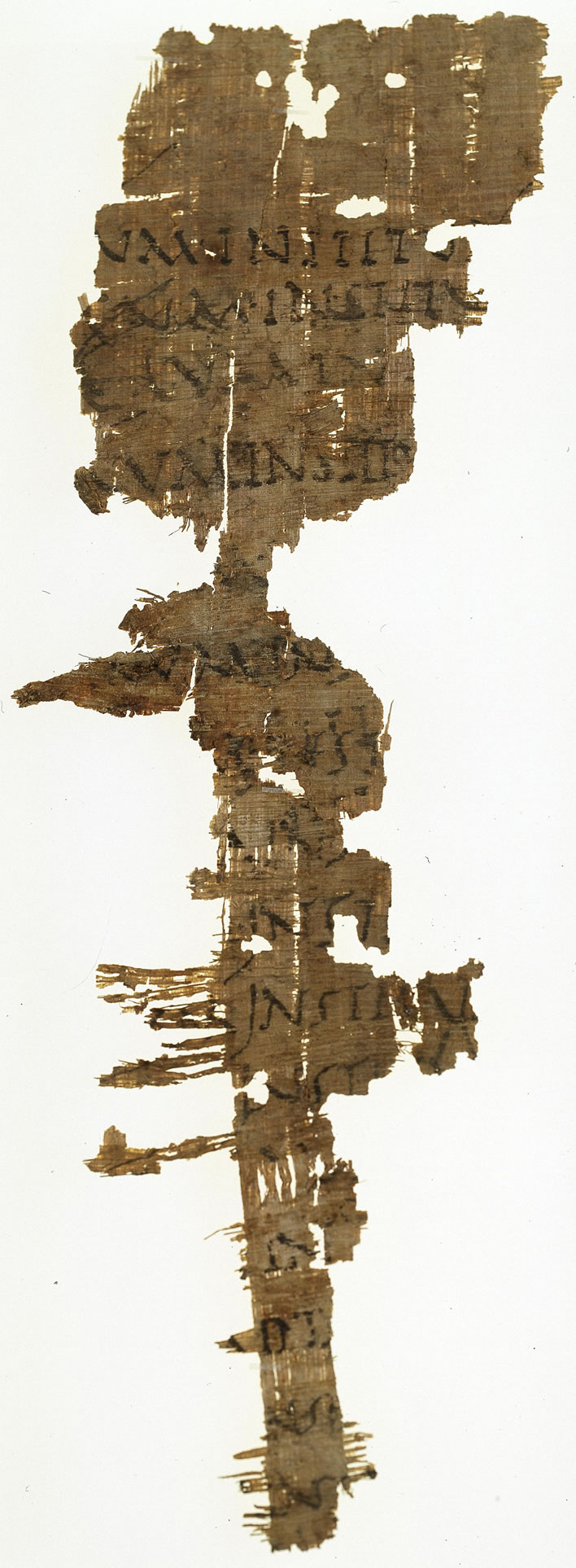
A good example of the structural vulnerability of papyrus, which disintegrates as soon as thhe cross-grain layers separate. A school papyrus from the 1st century AD written in Latin in capitals. Size 250 x 70 mm. University of Michigan commentary: 'Exercise in calligraphy: a sentence, starting with the words "Cum instituamus", copied 15 times from a model, by what appears to be at least five different hands.' Image: University of Michigan.
In sum, the technological advance of the codex proceded inseparably with the technological advance of parchment. The one would not have taken place without the other.

Parchment fragment from the 1st-2nd century AD, language Latin, size 85 x 50 mm. 'De Bellis Macedonicis, possibly by Lucius Arruntius.' BL commentary: 'Fragment of a Latin historical work, on parchment, concerning the Macedonian wars of Rome. Roman literary cursive, combining rustic capitals, uncials, and old Roman cursive. Medial points mark word divisions.' Image: British Library.

Parchment has a more robust structure papyrus but, as an organic product, is still subject to decomposition and tearing. Detail of a parchment fragment written in Latin dating from 5th century AD. A copy of a section from Cicero, Pro Plancio. Image: Berliner Papyrusdatenbank.
Inventing Catullus
Summing up, it seems that out of the heterogeneous collection of rolls that constituted Catullus' poetical works, in the critical transition to a codex a single collection was created out of at least some of the disparate rolls that were in circulation. What went into the codex was in effect a snapshot of a random assortment of rolls. We do not know what, if anything, was left out of the codex.
The grouping of the poems in the codex suggests that each group might have originated from a particular roll. The organization of the codex has therefore nothing to do with Catullus, but the collection can best be described as a anthology of his work by one or more persons three or four (or more) centuries after his death. The contents of the codex came from whatever rolls the compiler(s) currently had to hand and reflected his (or their) tastes and predelictions.
We cannot assume that the rolls that were used as the source for the codex copy were in good condition, either physically or textually – on the contrary, the four or five centuries that had passed since Catullus first wrote these poems would have certainly left their traces.
The wreckage of Europe
Classical writings not only had to jump the technological hurdle from papyrus roll to codex, they shortly afterwards had to survive the collapse of the Roman Empire and most of its civilisation along with it around 400 AD.
We have no space here to reconstruct the dimensions of that loss, but some scholars have argued that the loss was so great that, in view of the scraps that remain, we cannot consider that we have a 'Latin literature' worthy of the name. You might imagine yourself going into one of the great modern libraries with a couple of wheelbarrows, piling them up with books more or less at random, pushing them back outside and then setting fire to the building. That sort of loss.
After the collapse there followed three centuries in Europe – let us say a dozen generations – in which the memory of the Roman world largely disappeared from the minds of men. Its physical manifestations disappeared as nature and man reasserted itself over these imposters; the fine cut stones were used for cottages and religious buildings; the memory of those who cut and stacked these stones and pavings evaporated. The papyri and the codices written in a language that was becoming more incomprehensible with each generation were used to plug gaps in walls and burned to keep people warm in the cold climate of those centuries.
Some codices, particularly the religious ones, found their way into monasteries, some on the outer edges of Europe, particularly in Ireland and northern Britain. Among them were some secular works. As time passed the knowledge of the Latin language declined and these works and the names of their authors became meaningles scribbles to many.
Monastic recycling
Even in a monastic library, classical manuscripts were not safe. Some of the worldlier Church leaders such as Saint Augustine (354-430) or Saint Jerome (347-420) might conserve classical works (though perhaps not going to the expensive extent of having them copied), others such as Saint Gregory (540-604) would destroy them as works of the heathen.
Many would try to make money from them. In the Middle Ages it was common for monasteries and individual monks to make a bit of extra cash by cutting up the ancient heathen gibberish they could neither read nor understand to make psalters, breviaries and little votive amulets for the pious, the gullible and the superstitious. Sometimes the ancient text was scraped or scrubbed away, sometimes left for its magical properties. These amulets were hot sellers: the combination of ancient mumbo jumbo and a phrase from the bible covered all spiritual bases.
Whether a work survived, was destroyed or just lost through neglect did not in any way depend on what we now would consider to be the value of the work, it was just a matter of chance.
There will be Classical writers of whose existence we know nothing at all – not even blanks, because if there were blanks we would at least know that something was missing; there are writers who are alluded to in texts that have survived but whose work has never been found – they are the blanks in our knowledge – Licinius Calvus, Catullus' friend and fellow poet, is one of these; there are writers like Catullus whose work just happens to have survived – out of them we have the meagre Classical canon we know today.
Somehow, one codex of Catullus' work survived. Where it went we do not know. That codex entered a dark tunnel and would not reappear until a thousand years had passed.
The thousand year tunnel
We hear nothing of Catullus' work – tablets, rolls or codices – from after his death. We could actually say that the tunnel started at that point, but since we are now particularly concerned with that single codex survivor that brought his work down through the dark and perilous centuries to us, we can speak of the start of the tunnel as being the date that codex was created. We do not know that date.
That tunnel journey coincides with a time we call the Dark Ages. Much was lost that would later be rediscovered in the Renaissance, one of these losses was the widespread understanding of classical Latin. Church latin became a functional language for disquisition, but lost the subtleties of its classical parent. Writing styles in particular changed dramatically.
We have no idea what happened in that tunnel, no idea where the codex physically was, who and how many had access to it. As we said, the poet Catullus was a generous and talented user of obscenities: his poems are certainly not an improving read for Christian moralists, but perhaps that is what kept them in existence during the long nights in some monastic library. Who knows?
Or, my scrofulous French novel
On grey paper with blunt type!
Simply glance at it, you grovel
Hand and foot in Belial's gripe;
Browning, Robert. 'Soliloquy of the Spanish Cloister' in Dramatic Lyrics, 1842.
We must credit Charlemagne for the birth of the Holy Roman Empire and the beginning of the ascent of Europe into the light, but our real gratitude to him has to be the rescue of Latin learning on the continent of Europe, particularly effected through his appointment of Alcuin of York (735-804) to his court in 782.
During the centuries that followed, monastaries and libraries were founded, works were copied, the knowledge of the Latin language was preserved. In the sense of modern learning, though, this process was really only survival, not dissemination – there was copying, but nothing that we would recognised as philology. The manuscripts of the Classical world were merely stored, waiting for the men of the Renaissance to find them.
Tours
Were there several codices in other tunnels? Who knows?
We only know that in the ninth century, about halfway through our journey, somewhere in north eastern France, someone put together an anthology of Roman poetry, two pages of which contained a copy of one of Catullus' greatest poems, [c 62]. We have no idea how that single poem found its way into the ninth century anthology.
Not only is this poem great in absolute poetic terms, but it is also one of the few of Catullus' poems that is not laced with crackling vulgarity and pungent obscenity – it could be read to a maiden aunt, one who might enjoy the delicate but suggestive fragrances it exudes. In other words, a cleric could anthologise it for its fine Latin and impeccable metrics without needing – what's that word the sensitive ones use nowadays? – yes, 'redactions'.
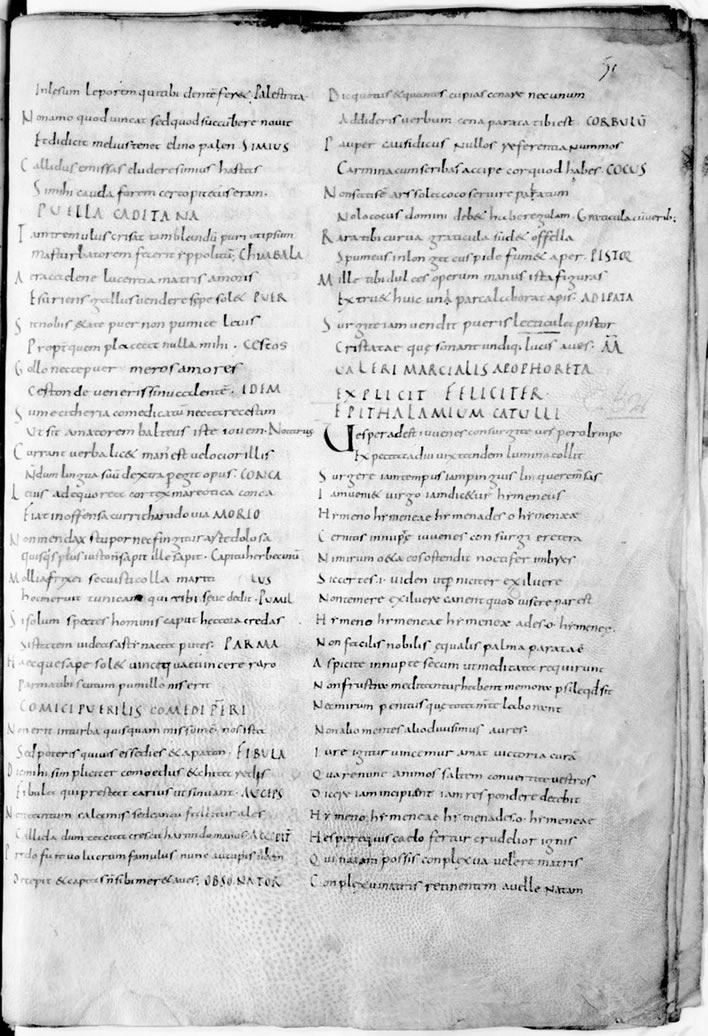
[c 62] Image: BnF, Manuscript T, 51r.
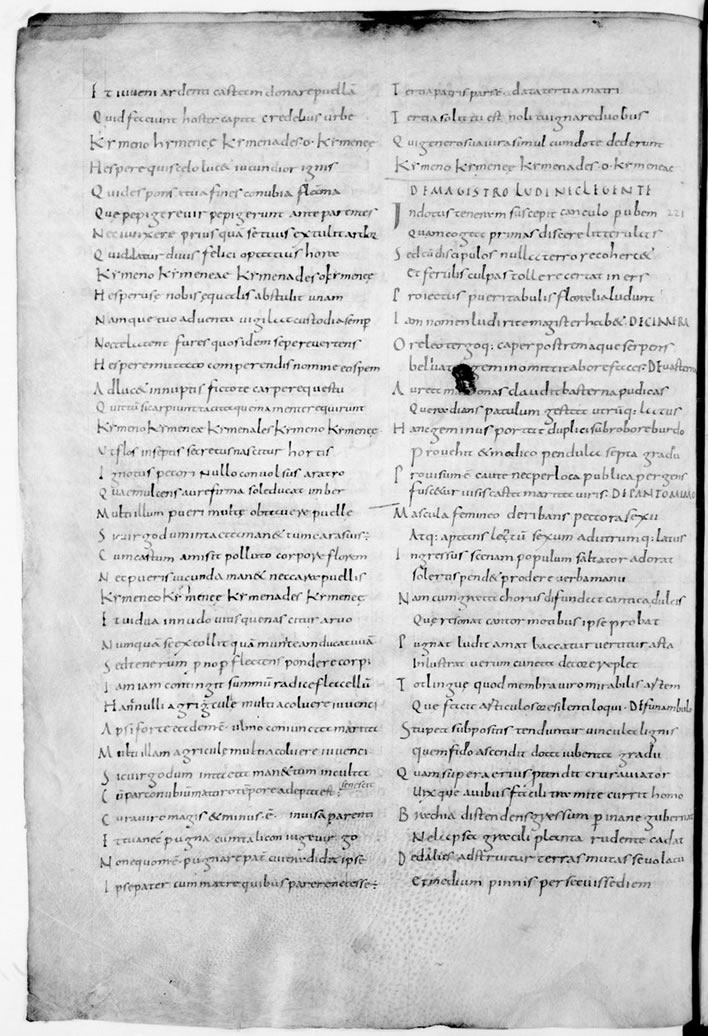
[c 62] Image: BnF, Manuscript T, 51v.
The 'Tours Anthology', the florilegium Thuaneum or codex Thuaneus, was copied around 875, apparently in Tours. This codex is known to scholars as 'T' – not from Tours, but from the collection in which it was found, that of Jacques Auguste de Thou (1553-1617). It seems certain that that poem came from our tunnel codex because they both share some of the same mistakes. Nevertheless, there are puzzling differences – did you expect this to be simple, Reader? – in that some of the transcriptions in [c 62] in the T manuscript are considered superior to those in the principal survivor, our 'tunnel codex'.
At this our ears prick up: Tours! And that means Alcuin, one of the great saviours of Classical culture.
Alcuin was put in charge of Marmoutier Abbey in Tours by Charlemagne in 796. The abbey had been founded by Saint Martin at the end of the fourth century. Alcuin turned the abbey into a centre of learning and book copying, frequently of originals from other institutions. He died in 804. Around fifty years later, according to the chronicles, the abbey was attacked by Vikings. There is some scholarly dispute about how much damage the Vikings (or Normans) did, but it took more than a century before the abbey recovered from this setback.
Was the Catullus codex at Tours in the ninth century – from the evidence presented by the anthology T? It certainly seems like it. Was the codex brought to Tours by Alcuin himself on one of his many journeys (around 781 he met the Pope in Rome and Charlemagne in Parma, about 100 km from Verona)? No idea. Was the codex sent to Verona sometime after the sack of the Abbey in 852? No idea. Somehow the Catullus codex appears to have travelled from Rome (or Verona, or somewhere else) to Tours and then back to Verona, ready for its 'discovery'.
Verona
All in all, neglecting our brief halt in the ninth century, that tunnel lasts a total of a thousand years and brings us finally into the late Middle Ages, when the codex emerges some time just before 1300 in Verona. Or perhaps not then and not there. A certain bishop Rather at Verona around 966 claims that he is reading Catullus, so perhaps the tunnel wasn't quite as long as we think.
As far as the 'reappearance' of the codex in Verona is concerned, we have to replace complete ignorance – our normal state – with complete bafflement.
The seeming 'discovery' of the codex is documented by a verse riddle by one Benvenuto Campesani, a notary from Vicenza, welcoming Catullus – that is, his poems – back to Verona. It is found only in the manuscripts G (with heading) and R (without heading).
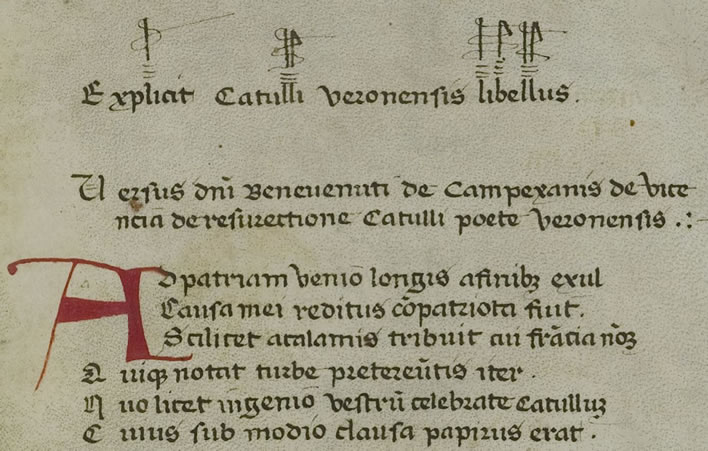
Benvenuto dei Campesani's verse riddle on the discovery of a Catullus codex.
Image: BnF, Manuscript G, 36r.
Lines by Messer Benvenuto dei Campesani of Vicenza on the resurrection of Catullus, Veronese poet.
An exile, I come to my homeland from a distant country:
the cause of my return was a compatriot,
namely a scribe to whom France assigned a name
and who marks the route of the passing crowd.
Celebrate with whatever talent you can your Catullus,
whose paper was shut up under a bushel-basket.
Versus domini Beneuenuti de Campexanis de Vice / ncia de resurectione Catulli poete Veronensis.
Ad patriam uenio longis a finibus exul: / causa mei reditus compatriota fuit, / scilicet a calamis tribuit cui Francia nomen / quique notat turbe praetereuntis iter. / quo licet ingenio uestrum celebrate Catullum, / cuius sub modio clausa papirus erat.
The latinist J. L. Butrica gives an interpretation of Campesani's riddle which is credible, but nevertheless the riddle remains fundamentally imponderable:
I suggest that Campesani's 'riddle' commemorates a notary named Francesco who metaphorically restored Catullus to life for his home-city by undertaking the challenge of copying the ancient Veronensis into a script comprehensible to his contemporaries – in other words, creating A, the copy of V from which O, X and thus all the other MSS derive, metaphorically taking the text out from under the bushel that had concealed it and making it accessible to readers and potential admirers.
Butrica, James L. 'History and Transmission of the Text' in Marilyn B. Skinner ed., A companion to Catullus, Blackwell, Oxford, 2007, p. 13-34. p. 27f.
Despite heroic flights of the imagination, no one really understands what the riddle means. Some think it implies that the codex had just been brought to Verona from… er, somewhere else: it may not have been discovered, just acquired. Some think the riddle implies that the manuscript, now known as the Codex Veronensis and referred to by scholars as 'V', was found under a basket or a bushel, which some locate in a wine cellar, or perhaps it was a beer barrel or it was a metaphorical light under a bushel… Myth upon myth.
The idea of the only copy of the works of a great, lascivious, foul-mouthed and probably frequently drunk poet being discovered under a wine barrel is just too attractive to resist. Sober reflection brings us to one conclusion: we just don't know where it was found, by whom and where it came from.
Butrica's proposed reading of Campesani's 'riddle' has one further advantage. It moves the focus of the 'resurrection' of the Catullus codex from the moment it was actually 'discovered' – that is, became public knowledge – to the creation of A, the first easily readable copy. As Butrica points out, 'Italian scholars were consulting V for as much as a century before any extant MS was copied', leaving behind them references and quotations. Those following the traditional interpretation of Campesani's riddle as a paean to the discovery of the original codex, V, are left with some explaining to do about the rationale behind the various immediate copies.
The Codex Veronensis, V, seems to have been around for possibly a century before it was copied, for during this time it was used as a source of quotations and references by several Italian scholars.
And we don't know where it went to, either, because the codex V was then lost, never to be seen again. No one knows what happened to it: it may have been destroyed accidentally by fire or deliberately by some defender of public morals, stolen, hidden and forgotten, in which case it may be in another tunnel or under another wine barrel and may re-emerge after another thousand years.
In this respect we have to consider that one Catullus manuscript, known as R, which had been used as a source for most of the copies made in the fifteenth century, was only discovered by scholars in 1896. Because of a cataloguing error it had been patiently waiting unnoticed by scholars in the Biblioteca Apostolica library in the Vatican for centuries. Who knows what the future may bring?
Fortunately, at some time in the period before V was lost it was copied, otherwise Catullus and his works would today just be a historical footnote and their thousand years in the tunnel would have been for nothing.
We have to remember that the survival of the Catullus codex was not the result of some institutional process but rather the result of the actions of a number of individuals who perceived a clear value in the original. Had one of these copying efforts not taken place, the chain would have been broken and as a result we would have no manuscript today and no Catullus.
The copies required effort, time and money. We moderns might assume that these 'copies' were somehow inferior reproductions, just a quick transcription of the text, whereas, on the contrary, they are artistic productions in their own right befitting a noble Renaissance library: beautifully written in the more readable humanist hands of the time, some with illuminated initials, all on expensive parchment.
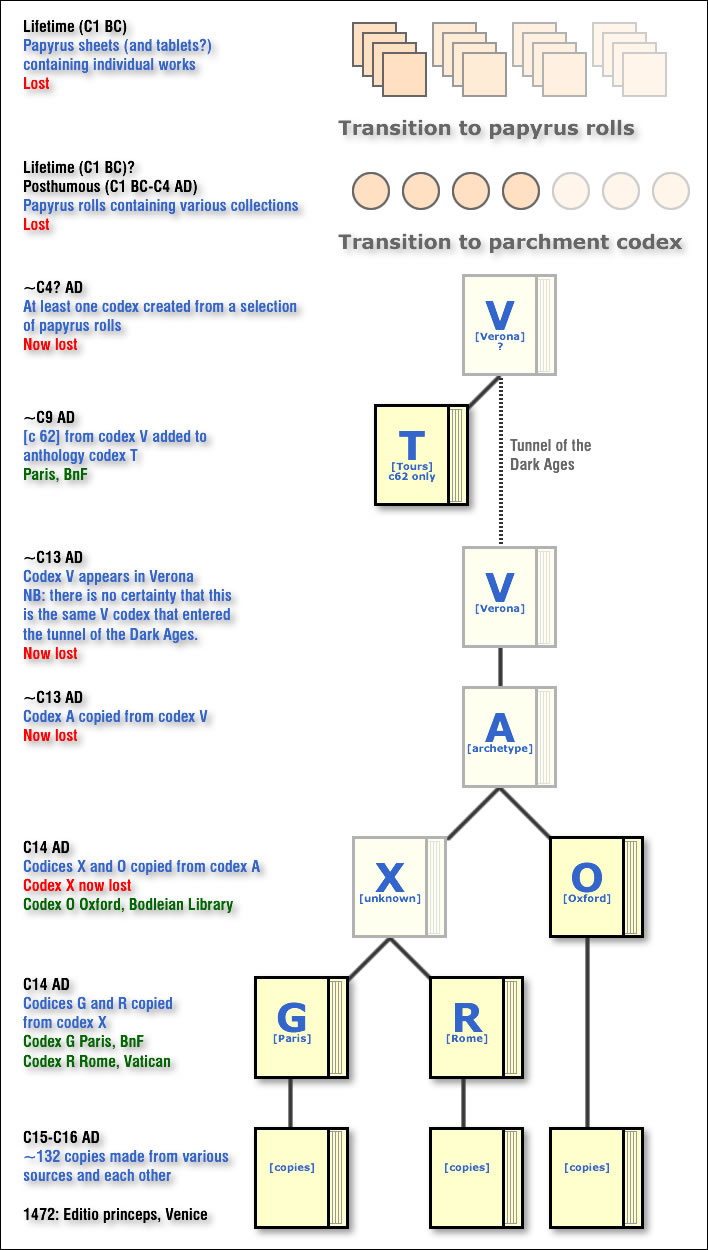
The great survivor: the transmission of Catullus' work down the centuries. Image: FoS (reuse only with link).
Recent research has done a lot to disentangle what happened next to Catullus' poems. There is no elegant way to recount this, but the diagram may help. V, the parent manuscript, was copied to a child version we know as A (for 'archetype'), which is now also lost to us. At some point in the time before it disappeared two copies were made from A, becoming the grandchildren, one called X (for 'unknown') and the other O (for Oxford, the current location of this manuscipt). Here is the first page of O, from the Bodleian Library in Oxford:

First page of the Oxford manuscript, O. Image: Bodleian Library, Oxford: Manuscript O, 1r.
Manuscript X is also lost, but before this happened two great-grandchildren were copied: G (now in Paris) and R (now in the Vatican). The Vatican is not happy to let the laity look at R in a useful resolution, but here is the first page of G, from the Bibliothèque nationale de France in Paris:

First page of the Paris manuscript, G. Image: BnF, Manuscript G, 1r.
It appears that Campesani's riddle about the finding of V, the ancient parent, (or more precisely its copying into a readable form) was added to one of the two lost intermediaries: either A the child or X, one of the two grandchildren. Since then, grandchild and grandchildren have been copied and their copies copied. Absolutely clear.
The original manuscript, V, was seemingly full of errors. It is presumed that it was written in a Gothic script, which would make it heavy going for the readers of uncial scripts centuries later. This is one of the reasons for the erratic texts in subsequent copies, but every copyist introduced some more of their own and corrected real or imagined mistakes, frequently with other mistakes in a long sequence of copies of copies. Certainly, the later copyists were aware of the problem of corruption, but, lacking other sources, were helpless to do anything about it. In the 14th century a scribe apologised openly for the corruption of the text he was transcribing. The apology is in manuscript G and is remarkably perceptive – only the hard-hearted could remain critical:

The scribe's lament (Antonio del Gaio da Legnago) in manuscript G.
Image: BnF, Manuscript G, 36r.
You, reader, whoever you are to whose hands this book may find its way, grant pardon to the scribe if you think it corrupt. For he transcribed it from an exemplar which was itself very corrupt. Indeed, there was nothing else available, from which he could have the opportunity of copying this book; and in order to assemble something from this rough and ready source, he decided that it was better to have it in a corrupt state than not to have it at all, while hoping still to be able to correct it from another copy which might happen to emerge. Fare you well, if you do not curse him.
Tu lector quicumque ad cuius manus hic libellus obvenerit Scriptori da veniam si tibi cor[r]uptus videtur. Quoniam a corruptissimo exemplari transcripsit. Non enim quodpiam aliud extabat, unde posset libelli huius habere copiam exemplandi. Et ut ex ipso salebroso aliquid tamen sugge[re]ret decrevit pocius tamen cor[r]uptum habere quam omnino carere. Sperans adhuc ab aliquo alio fortuito emergente hunc posse cor[r]igere. Valebis si ei imprecatus non fueris.
There are currently nearly 150 manuscripts of parts or all of the poems in existence. The one codex, V, whch survived the Middle Ages is now lost. The anchor chain that once held us to a fourth century Catullus has broken and we are now textually adrift on a sea of multiplying errors.
Trying to disentangle the results of the repeated copying processes which out of that one survivor codex that turned up in Verona ultimately generated around 150 copies has put food on the table of generations of Latinists. Copyists often misread their source, misunderstood it or corrected it according to their own lights; they often substituted prudish readings of the obscene original. Each generation of copyist 'improved' the work of the previous generation.
By tracking the corruptions in the texts of all these copies scholars have been able to determine the relationships between them. Unimaginably many hours of drudgery and scholarly infighting have reconstructed the ontological tree of these manuscripts and restored the text somewhat, but there are still many hundreds of emendations that can still only be labelled as 'speculative', and still much to do.
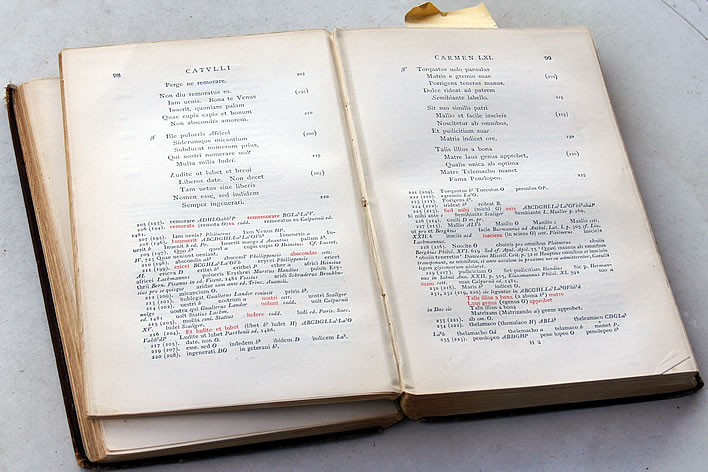
The author's copy of Robinson Ellis' 1878 edition of Catullus, turning itself into a disintegrated paper codex with a broken back – an interlineal palimpsest even on some pages – as the years go by, much like its owner. Image: FoS.
So that, when today you buy a slim paperback volume of the poems of Catullus – 116 poems probably occupying fewer than 200 pages of clear, clean text; so easy and convenient – you should think of the seven centuries of tireless effort that have gone into creating that handy and presentable package out of the squiggles, blots and stains of that one lost codex that emerged from the tunnel of the Dark Ages.
The magnificent [c 62] saw the light of day briefly in the ninth century, in codex T. We have no idea at all of what went before that, either codex or rolls. Here are the first two stanzas of that poem as they appear in T:
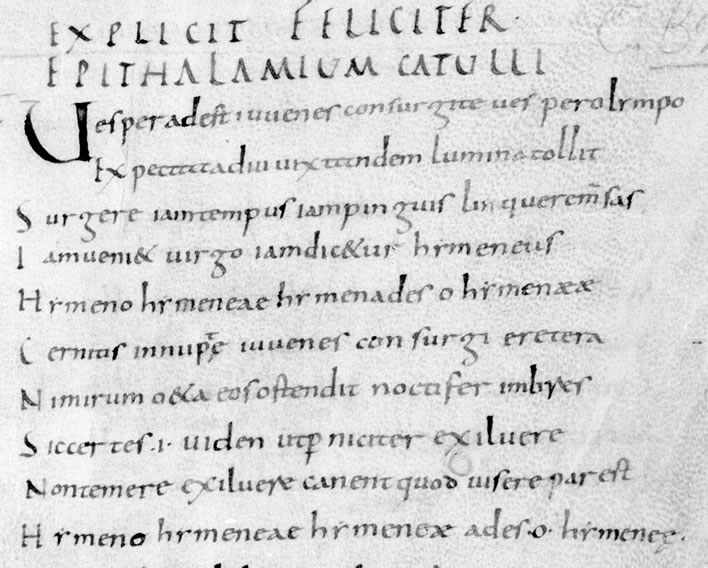
[c 62] Image: BnF, Manuscript T, 51r.
Then in the fourteenth century the major copies, O and G came into existence. Here is [c 62] in O:
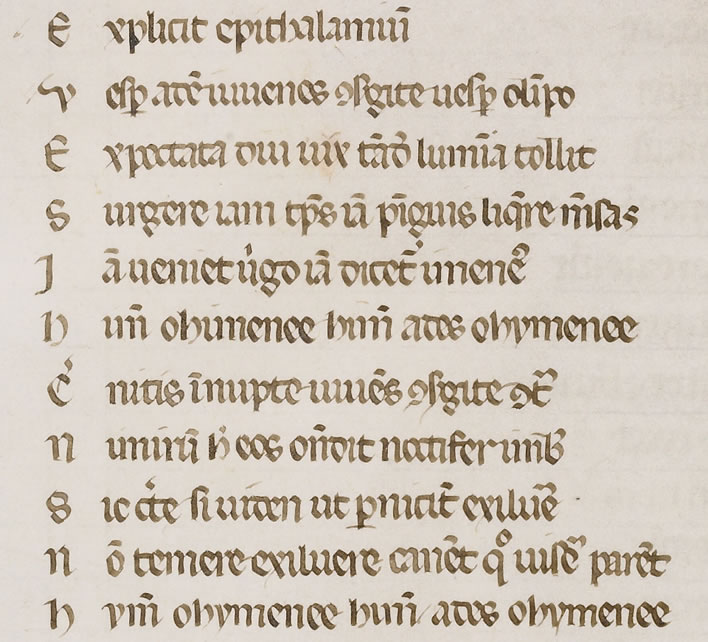
And in G:

[c 62] Image: BnF, Manuscript G, 17v.
Five hundred years of speculation and scholarship brings us to the great nineteenth editors. Here is the result of Robinson Ellis' labours on the first two stanzas of [c 62]:

Robinson Ellis' reading of [c 62], 'Hesper adest' in Ellis, Robinson. A Commentary on Catullus, Oxford, 1889, p. 100-102.Image: FoS.
And what we now find in basic Latin editions of Catullus is clean, free of doubt and highly sanitised:
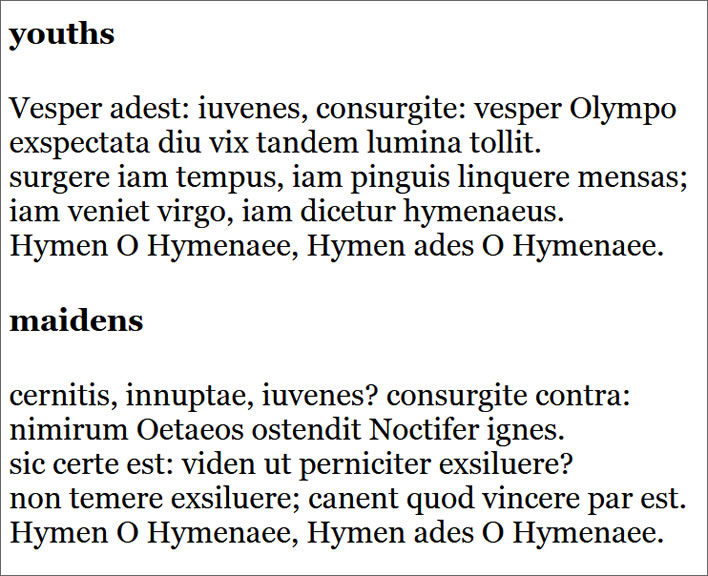
Merrill's text of [c 62] in Perseus Image: FoS.
But one should remember that that whatever flavour of text and translation you take into your hands in the bookshop, the original text is still a work in progress, eight centuries after its resurrection in Verona and twenty-one centuries after its author wrote it.
Drudgery in the service of art
In his poem The Scholars, W.B. Yeats took a potshot the 'bald heads' who devoted their lives to the tedious drudgery that was needed to establish the taxonomy of the manuscripts that we have and reconstruct the texts they contain:
Bald heads forgetful of their sins,
Old, learned, respectable bald heads
Edit and annotate the lines
That young men, tossing on their beds,
Rhymed out in love’s despair
To flatter beauty’s ignorant ear.All shuffle there; all cough in ink;
All wear the carpet with their shoes;
All think what other people think;
All know the man their neighbour knows.
Lord, what would they say
Did their Catullus walk that way?
W. B. Yeats, 'The Scholars', from 'The Wild Swans at Coole' (1919) in Collected Poems, Macmillan, London, 1965, p. 158.
Yeats wrote the first version of this poem in 1915. In 1929, no longer a young man tossing on his bed, he revisited the poem and rewrote the second stanza, improving it greatly, particularly in its metrical consistency. The text here is therefore that of the 1929 version, reproduced as it appears in the 'definitive' Macmillan edition of the Collected Poems.
Yeats' poem is a cheap jibe at the shuffling street sweepers of literature: he certainly would not have appreciated it had his poetry undergone the sort of extensive mutilation that Catullus' work suffered down the centuries. The irony of his substantial revision of his own poem seems to be lost on him: his readers are now confronted with two versions of this poem, the first of which, the 'defective' version, has gained absolute ascendency on the internet (possibly because it cleared copyright restrictions before the later revision). Yeats now needs the help of the scholars he despises to sort his own mess out.
The question must always be: what did Catullus actually write? And what did he understand by what he wrote? Since Yeats has given us the image of our poets as 'young men … in love’s despair', let's look at Catullus' great passion, the woman he named Lesbia.
0 Comments UTC Loaded:
Input rules for comments: No HTML, no images. Comments can be nested to a depth of eight. Surround a long quotation with curly braces: {blockquote}. Well-formed URLs will be rendered as links automatically. Do not click on links unless you are confident that they are safe. You have been warned!